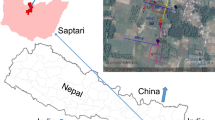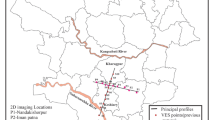Abstract
Chandrabhaga basin of the Nagpur district is a part of the drought prone Vidarbha region of Maharashtra, India. This region is facing acute shortage of water for drinking and irrigation purposes. The basin is located at the eastern fringe of the Deccan traps consisting of volcanic rocks. Presently, dug wells penetrating composite layers of the weathered mantle and highly fractured rocks overlying stratified basaltic lava flows are the main source of water supply. However, water available in the dug wells is inadequate to meet the ever increasing demand for water causing considerable economic losses to the farming community. In this work, we present the results of an electrical resistivity tomography (ERT) survey carried out in the basin for the delineation of groundwater potential zones. Validity of the hydrogeological setup obtained from the ERT results has been confirmed by bore well drillings at two investigated sites. The study demonstrates the efficacy of the ERT technique in delineation of groundwater potential zones in the hydrogeologically complex basaltic terrain of the Deccan traps.











Similar content being viewed by others
References
Abdullahi NK, Osazuwa IB, Sule PO (2011) Application of integrated geophysical techniques in the investigation of groundwater contamination: a case study of municipal solid waste leachate, Ozean. J Appl Sci 4:7–25
Anthony AA, John RO (2010) 2-D electrical imaging and it’s application in groundwater exploration in parts of Kumbani river basin, Zaria, Nigeria. World Rural Obs 2(2):72–82
Bose RN, Ramkrishna TS (1978) Electrical resistivity surveys for groundwater in the Deccan trap country of Sangali district, Maharashtra. J Hydrol 38:209–221
Central Ground Water Board (2003) Groundwater resources and development potential of Nagpur district, Maharashtra. Report, Central region, Nagpur, pp 74
Central Ground Water Board (2006) Basic data report of exploratory well at Jhunki (Shindi), Kalmeshwar taluk, Nagpur district, Maharashtra. 1464-A/BDR/2006, pp 10
Ghosh P, Sayeed MRG, Islam R, Hundekari SM (2006) Interbasaltic clay (bole bed) horizons from Deccan traps of India: implications for palaeo climate during Deccan trap volcanism. Palaeogeogr Palaeoclimatol Palaeoecol 242:90–190
Hamzah U, Yaacup R, Samsudin AR, Ayub MS (2006) Electrical imaging of the groundwater aquifer at Banting, Selangor, Malaysia. Environ Geol 49:1156–1162
Kadri Md, Nawawi MNM (2010) Groundwater exploration using 2-D resistivity imaging in Pagoh, Johar, Malaysia. AIP Conference proceeding, pp 151–154
Kumar D, Thiagarajan S, Rai SN (2011) Deciphering geothermal resources in Deccan traps region using electrical resistivity tomography technique. J Geol Soc India 78:541–548
Limaye SD (2010) Review: groundwater development and management in the Deccan traps(basalt) of western India. Hydrogeol J 18:543–558
Loke MH (1997) Software: RES 2D INV. 2-D interpretation for DC resistivity and IP for Windows 95. 5, Cangkat Minden Lorong 6, Minden Heights, 11700, Penang, Malaysia
Loke MH (2000) Electrical imaging surveys for environmental and engineering studies: a practical guide to 2-D and 3-D surveys, pp 61
Mehta M (1989) Groundwater resources and development potential of Nagpur district, Maharashtra, CGWB report no. 434/DR/12/89
Muralidharan D, Deshmukh SD, Rangrajan R, Krishna VSR, Athavale RN (1994) Deep resistivity surveys for delineation of Deccan trap-Gondwana contact and selection of water well sites in Jam river basin. Tech. report no. NGRI-94-GW-153, pp 63
Osazuwa IB, Chii EC (2010) Two-dimensional electrical resistivity survey around the periphery of an artificial lake in the Precambrian basement complex of northern Nigeria. Inter J Phys Sci 5(3):238–245
Owen RJ, Gwavava O, Gwaze P (2005) Multi-electrode resistivity survey for groundwater exploration in the Harare greenstone belt, Zimbabwe. Hydrogeol J 14:244–252
Rai SN, Thiagarajan S, Ratnakumari Y (2011) Exploration for ground water in the basaltic Deccan trap terrain in Katol taluk, Nagpur district, India. Curr Sci 101(9):1198–1204
Rai SN, Thiagarajan S, Ratnakumari Y, Kumar D (2012) Exploring Deccan traps for groundwater in parts of Kalmeshwar taluk, Nagpur district, India. J Appl Hydrol XXV(3&4):85–94
Rai SN, Thiagarajan S, Ratnakumari Y, Anand Rao V, Manglik A (2013a) Delineation of aquifers in basaltic hard rock terrain. J Earth Syst Sci 122(1):29–41
Rai SN, Thiagarajan S, Kumar D, Dubey KM, Rai PK, Ramchandran A, Nithya B (2013b) Electrical resistivity tomography for groundwater exploration in a granitic terrain in NGRI campus. Curr Sci 105(10):1410–1418
Rai SN, Thiagarajan S, Shankar GBK, Sateesh Kumar M, Venkatesam V, Mahesh G, Rangarajan R (2015) Groundwater prospecting in Deccan traps covered Tawarja basin using Electrical Resistivity Tomography. J Ind Geophys Union 19(3):256–269
Rao TG, Athavale RN, Singh VS, Muralidharan D, Murthy NN (1983) Geophysical exploration for ground water in Deccan traps of Godavari Purna basin, Maharashtra. NGRI technical report no. GH 18-GP10
Ratnakumari Y, Rai SN, Thiagarajan S, Kumar D (2012) 2-D electrical resistivity imaging for delineation of deeper aquifers in parts of Chandrabhaga basin. Curr Sci 102(1):61–69
Yadav GS, Singh SK (2007) Integrated resistivity surveys for delineation of fractures for groundwater exploration in hard rock areas. J Appl Geophys 62:301–312
Acknowledgements
The authors are grateful to the Director, CSIR-National Geophysical Research Institute for his permission to publish this work. Our thanks are due to anonymous reviewer for his constructive criticism and numerous corrections which have been very useful in improving the manuscript. We thank L. Adilakshmi for preparing the location map using GIS platform.
Author information
Authors and Affiliations
Corresponding author
Rights and permissions
About this article
Cite this article
Thiagarajan, S., Rai, S.N., Kumar, D. et al. Delineation of groundwater resources using electrical resistivity tomography. Arab J Geosci 11, 212 (2018). https://doi.org/10.1007/s12517-018-3562-y
Received:
Accepted:
Published:
DOI: https://doi.org/10.1007/s12517-018-3562-y




